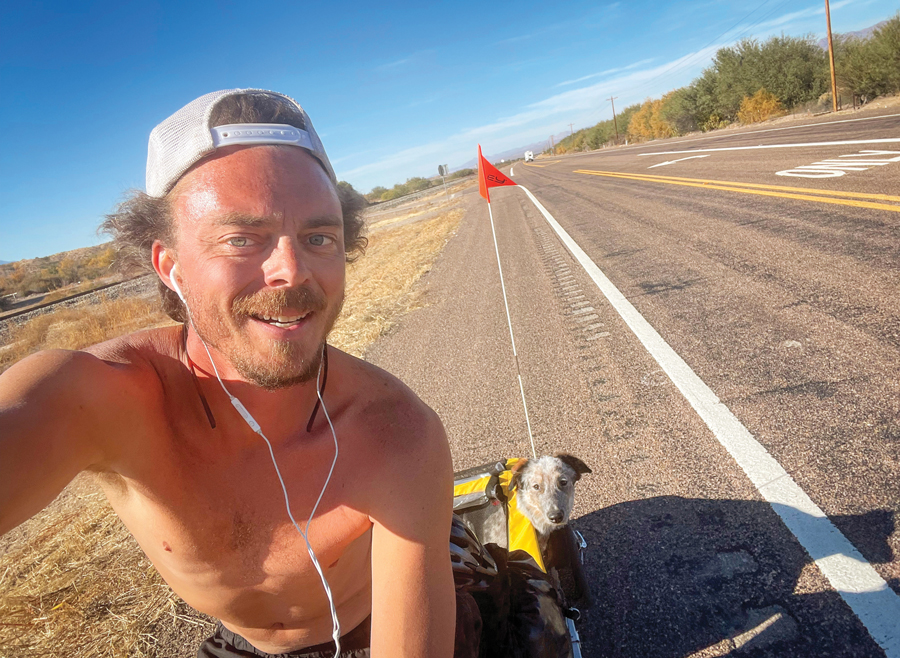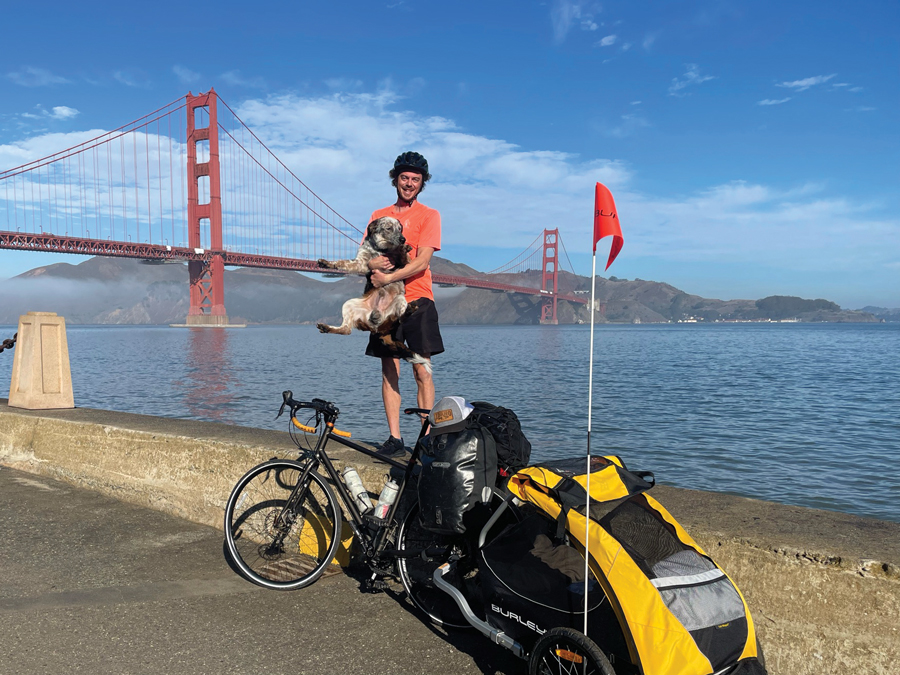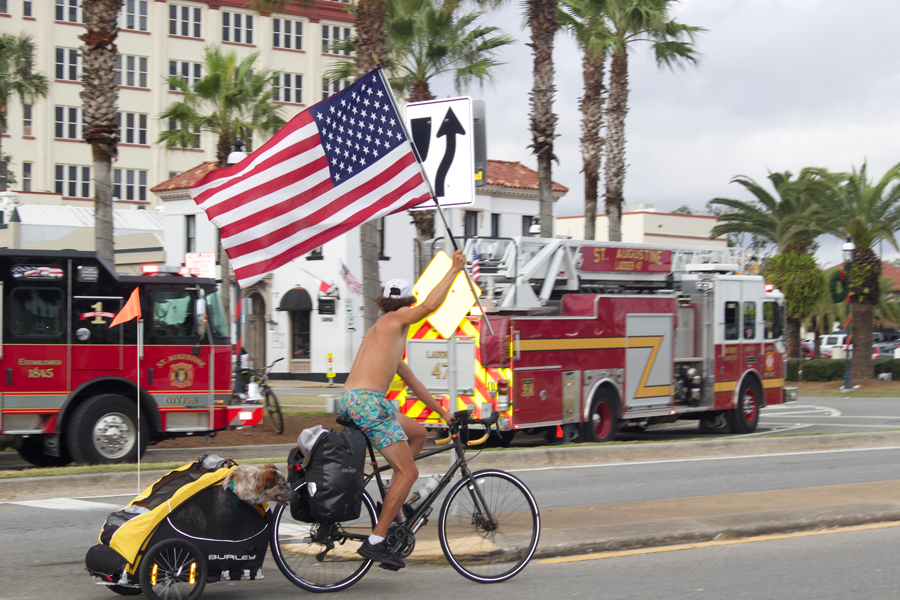Cycle Therapy
Life is not defined by your weaknesses, the adversity you face, or your many shortcomings. Life will be defined by how you build strength in the face of that weakness, how you build character, fortitude, and tenacity to overcome adversity, and how you turn your shortcomings, mental health struggles, grief, despair, or financial issues into a stronger and fiercer, braver you. When you overcome, heal, and let go, you will come out the other end tougher and you may find the fighter buried within you.
In November 2020, I hiked off an unnamed mountain in Yosemite National Park. The rains and snow were coming, and the federal government was laying off seasonal wildland firefighters, as they do every year. I had spent the last four years as a wildland firefighter, on an engine, a module, and two as a Snake River Hotshot. That last day of the season is bittersweet. The 16-hour days and two days off a month are behind you now. You say goodbye to the daily purpose, goals, and camaraderie, and everyone heads their different directions with the next six months off.
But what happens to firefighters in the off-season is rarely spoken of. Many have issues with mental health, and no one talks about it. You believe that you’re too tough to be fragile, learning only later that to be tough is to be fragile.
As I drove out of Yosemite, saying goodbye to magnificent granite walls, the friendly bears, and the world-renowned waterfalls, I was struck with gratitude — what a blessing it was to call this place home for the last six months. I headed to Big Sur, on the lush Pacific Coast, to regroup my thoughts and daydream about the adventures I would take this off-season.
That joy and satisfaction were quickly struck down. As I pulled my truck up to the cliffside overlooking the Pacific Ocean, waves tumbling violently onto the rocky shore and the sun dripping away on the horizon, I was hit with a feeling like I had never known: my heart pounded, my lips shook, my vision blurred. I was having my first severe panic attack, which felt like the devil was stripping life from me. I thought I was dying. I didn’t get out of my truck; instead, I drank a beer, then two, three, four, five. I was so confused and in fear of what was happening, and I was drinking to calm down. I sat there suffering as I wrote a letter to my little brother apologizing for long-ago worries and life advice, thinking this might be my last night alive. After a few too many beers, and the sun long gone, I finally got out of my truck. The moonless night and the ruralness of Big Sur cast a sea of stars that inspired thought. “What is going on? Am I really dying?”

No, I wasn’t fixing to die, but panic attacks, they say, can be worse than heart attacks. For the next year, I suffered daily with a severe panic disorder that spiraled into a dark depression. It took me eight months of silently coping with this crippling mental condition to finally seek help. I would be hit with panic at 6:00 AM, and the only tool I thought I had to deal with it was alcohol, so I traded coffee for a few beers. Or it would hit at 10:00 PM, and instead of drinking water before bed, I would drink three or four beers to calm down. It was scary, but sleeping was the only time I felt safe. I didn’t want to drink; I wanted that coffee, I wanted that ice-cold water, I wanted peace again. This constant panic was like an ever-growing tornado knocking down my brain and my positive mindset. As I realized this was now my life — debilitating panic attacks and depression — my hope quickly vanished. Stubborn to a fault, I never spoke about it.
When I finally did, doctors hardly listened to me, but they were glad to throw medication after medication at me. This only intensified my depression and panic, and doubled down on my hopeless mind. I was allergic to the last drug I was on. After telling the doctor about my side effects — bloody noses, vomiting, rashes, restlessness, irritability, trouble sleeping, fatigue, hopelessness, an increase in anxiety and depression, losing interest in anything, being an asshole to everyone, feeling empty — what did she do? She went ahead and doubled my dosage and said I was probably bipolar. Looking back, I’m baffled that I blindly followed. I was willing to grab any rope to pull me out of this hole; I just wanted to feel better and calm again, so I trusted a medically trained professional. It was so hard to ask for help, and when I did it only destroyed me further.
I stopped seeing that doctor and weened myself off that drug, which was brutal. I came seconds away from killing myself, twice, and if I had had a gun, I would not be writing this. When I sat in my apartment alone, suicidal, with the lights off and empty beer cans sprawled over the floor, something happened — a miracle.
“I need to get out of here and do something,” I thought. I had never been suicidal, and during those nights consumed in it, almost committing that act shook me awake. The only long adventure I could think to do was to ride my bicycle on the Southern Tier. I knew I could not stay in Salt Lake City, work a nine-to-five, go to therapy once a week, and snap out of this. I had to challenge myself, battle my demons head-on, and I was ready. I looked at my puppy, Rocky, and said, “Buddy, we’re going for an adventure.” I called Burk Minor at the Wildland Firefighter Foundation and left a voicemail. I said I was a wildland firefighter suffering with some serious mental illness, I was heading out to California to ride my bicycle across the country, and in helping myself I wanted to give back and raise money for the foundation.
The Wildland Firefighter Foundation’s focus is “to help families of firefighters killed in the line of duty,” which I support. I believe they’re angels on earth with the work they do.
The Southern Tier Bicycle Route, created by Adventure Cycling, is a 3,000-mile route from California to Florida, scurrying along the eight southern states of the U.S., a magical ride from the Pacific to the Atlantic Ocean, palm trees to cactus to palm trees.
As I set off for California, I had three goals on this journey. One: raise myself from my own ashes. I was on a mission to find clarity, fight my demons, overcome my depression, and find calmness to my extreme panic and anxiety. Also, to find peace, strength, forgiveness, confidence, and happiness throughout. Truly, I just wanted to break free of this suffering and to be the happy, positive, kind, and compassionate man I once was. Two, I wanted to raise a lot of money for the Wildland Firefighter Foundation. And three, I hoped to raise awareness for mental illness and health, spread my message of what I went through, and encourage others to not be afraid and to speak out and to know they’re not alone.

On October 31, Rocky in tow, we made it to San Francisco. He played fetch as I watched the fog swallow the Golden Gate Bridge. Being a wildland firefighter, we have a saying: “Nobody cares, dig harder.” With that in mind, I added 500 miles to the Southern Tier. Also, I wanted to ride this coastline, where this hell all started a year ago, and put it to bed.
With 5,000 miles of bike touring in previous years, I knew what was in store. However, adding my dog, his trailer, and supplies put my pulling weight at 170 pounds that first day. A lot different than just my two panniers, and I had no training and had never towed a trailer before. Climbing up from the ocean, on my first hill, sweat poured down me like never before. I remember calling my father and laughing with how darn heavy this load was. “I will never ever tow a dog again!” Funny thing to say in the first three miles, but it was true. As Rocky and I trudged down that coastline toward San Diego, it felt like with every gust of wind, a piece of my suffering would fly away with it.
I was in the saddle again, my happy place. I had a mission in front of me, and my fighting, optimistic spirit was reborn.
We were blessed with light rains, majestic sunsets, great winds, and amazing, shirt-off riding conditions from the California coast through Arizona. As I was riding into Apache Tribal lands, I was warned of the potential danger of camping and passing through. I take everyone’s advice with a grain of salt. Stubbornness, I guess. I didn’t let that fog my vision, and that 100-mile stretch across ancient, sacred land was one of the most special moments of my trip, my journey back to life.
As I pulled into the famous Apache Burger, in Peridot, Arizona, I was greeted with a humbling moment like no other. The day before, I was interviewed by Brittany Bade with CBS in Albuquerque, New Mexico, via video call. Bade had reached out after hearing about my story from a Santa Fe Hotshot, as news of my story had spread through the wildland firefighter community. It was on the nightly news, and as I waited in the long line to order a burger, this gentle giant of a man recognized me. He smiled and leaned over and said, “Hey, are you that firefighter riding across the country for charity? Is that Rocky?” I laughed, smiled back, and replied, “Yes, sir.” He turned around facing the 50-odd people in the restaurant and yelled about the news story and who I was, a shy moment but humbling as people clapped. He was a tribal youth leader with a group of eight or nine teenagers. They had just left a gathering and parade event and were heading home. He approached me when I was outside with Rocky and said, “Kevin, we would like to do something for you.” The kids shuffled off the bus, one carrying a drum. We were at a glorified truck stop, with people coming in and out, as Rocky and I rested in a sliver of shade. He went on, “We want to sing you a song, it’s called ‘Going Home,’ an ancient Apache song for warriors and hunters wishing them safe travels to get back home.” I was humbled, honored, and taken aback. As the one boy beat on the drum, they all sang in Apache. It was beautiful. I had no understanding of the words, but I could feel the energy, the power, and I was overcome with emotion. I pulled my sunglasses down and wiped away tears as they finished.
I shook all the kids’ hands and told them thank you. I hugged the tribal leader, and he told me, “That will keep you safe, brother. We will all pray for you, the entire Apache Nation, and we are honored to meet you. I love what you’re doing, keep pedaling.”
In awe of what happened, I pedaled into the sunset, hopped a fence, hid my bike, and camped on a hillside overlooking the sacred lands. I recalled the moment of them chanting as the sun kissed the horizon and shone red, pink, and orange in every direction. What a special day to be on the Southern Tier.

The next morning, another Apache at a gas station heard of our tale. He pulled over, shook my hand, and gave me five dollars. He welcomed me to the Apache Lands and wanted to give me a gift to keep me safe and strong. He grabbed a long knife from his hip and removed his cowboy hat, which had an arrowhead attached to it with some sinew. He cut off the arrowhead and handed it to me. A Navajo friend later told me of the rarity of this gift, an Apache cutting off the arrowhead on his grandfather’s gifted cowboy hat and giving it to a white man. The Apache people showed me kindness, compassion, and love — it was incredible moments like these that brought me back to life.
After 1,500 miles of riding, grinding, and climbing, I was coming over the hills into Alpine, Texas. With an incredible tailwind the entire day, this century ride was the most special of the entire tour. The sunset over the rocky hills felt like I was on another planet. I was reborn, and for the first time in a long time I embodied peace and hope as a smile consumed my face and 103 miles struck on my day’s odometer. As I took a short break before descending into town, I felt genuine peace and clarity again, like I had overcome my depression and shed my panic disorder away. What helped me so much to get to this point was riding these long stretches in the middle of nowhere and having no escape. When a panic attack would strike or my depression would attempt to crush my motivation, I had nowhere to run to. I couldn’t call a friend and go get a beer; with no service most of the time, I literally couldn’t call anyone anyway. It was just me, and I was forced to sit with my emotions, cope with them, work through them, and keep pedaling. Confronting my demons head-on, that’s what changed my mindset.
I learned that when I was struggling with my mental illness, I thought that this was my life and there was nothing else. That was only my perception; that wasn’t my reality. I had lived 33 years not feeling this way, and only one year in this hell. This mental illness will always be a part of me, but that’s just it — it’s just a part. My reality is much different. We will all have hard times in life, that is inevitable. But how we deal with these issues is what makes us who we are. It took me a year of silence, suffering on my own, to finally break free and ride my bicycle across the country.
It was the daily grind, those 100-mile days, the firefighters who assisted me along the route, the selfless strangers who bought me lunch, the construction workers who cheered me on as I rode by, the tailwind that inspired me to go farther, and the headwind that tried to kill my motivation only to fuel it. Those hot, steep, slow, and grueling climbs, and those riveting descents. Those two flat tire days, those moments of stuffing every snack into your mouth as you throw your bike down in ravenous hunger. That lightning bolt over my head, those indescribable sunsets, those moments by myself feeling free and strong and yelling “Yeehawww!” into the abyss. There is so much that happens on a bike tour that you have to do it in order to understand. What I can say in my 10,000 miles of touring around the U.S. is that it’s one of the best decisions I’ve ever made. One day in the saddle can put you through every emotion imaginable, the highest of the highs and the lowest of the lows, physically, emotionally, and literally.
The last 27 miles into St. Augustine, Florida, was a remarkable moment. The Deputy Fire Chief rode the last stretch with me, a fire truck followed from behind with its lights on, and they handed me an American flag for the last mile. A few fire trucks, police cars, an ambulance, and a group of maybe 30 people with signs cheered me on as I came through the finish line. I waved the American flag down that historic street and that was it.
Roughly $20,000 raised for Wildland Firefighter Foundation, 3,500 miles, 47 riding days, 15 century rides, five rest days, three flat tires, and one happy puppy.
The Southern Tier saved my life, but a lot of people aren’t so lucky. Speaking about mental illness and mental health shouldn’t be something we’re afraid to do, and we need to check in on each other more often. We are all one on this planet; we must be compassionate, supportive, motivating, and kind to all. It’s a big, beautiful world out there, full of awesome humans. I hope you go out there and see it.
Nuts & Bolts
Planning a Charity Ride
Pass it on
Connecting with a larger charity event is a great way to get started raising awareness for a cause. Many charities will help broadcast your message, share social media posts, connect you with support networks, and reach out to media in various areas of your ride.
Keep it going
Be prepared to do some legwork, however, and not just up those hills. Developing an “elevator pitch” of sorts to be able to tell people you meet about your trip is a great way to ease anxiety about getting your message across. You may also need to pitch news outlets yourself, in which case having a succinct way of talking about your trip and the reasoning behind it is a great way to convince media outlets to speak with you.
Call it in
Don’t struggle in silence. Dial 988 anywhere in the U.S. for confidential, compassionate, and free care.

